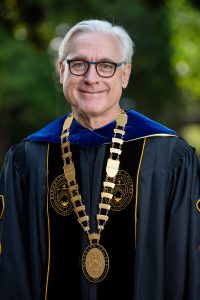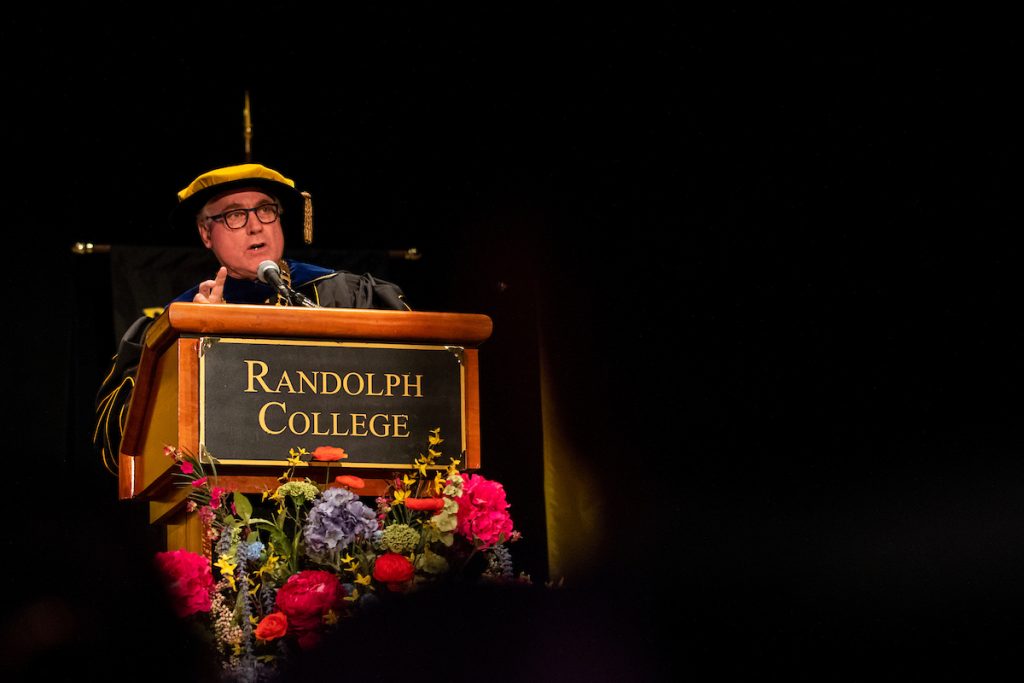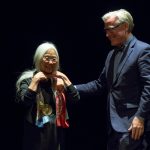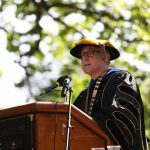A More Abundant Life: Bradley W. Bateman leaves legacy of growth, transformation, and community

Randolph College President Bradley W. Bateman
It’s a familiar sight at Randolph College. Each August, first-years are greeted by an enthusiastic welcome team of students, faculty, and staff as they arrive on campus for move-in day.
President Bradley W. Bateman has often been among them, lugging boxes and maneuvering mini fridges along the brick paths of front campus.
He vividly remembers his first experience—just weeks after arriving on campus himself. With rain drenching everyone and everything in sight, Bateman and the rest of the welcome crew powered on, trying to make the move-in process as easy as possible for families.
“My favorite tradition is the way the community comes out on that day and helps move them into the dorm to make them part of the family,” said Bateman, who will retire in June after nine years as president. “I love that day and that feeling, and the energy people have for helping others. It’s a wonderful tradition.”
That diverse, tight-knit community is a hallmark of Randolph College and something Bateman has come to value during his nine years behind the Red Brick Wall—and one of the things he will miss the most.
“I think that seeing and experiencing this interconnectedness between people is crucial,” he added. “The learning in the classroom is not remote and detached; instead, the students constantly see how what they are learning in the classroom manifests in everyday life. I believe that this creates a different kind of graduate than one sees at a larger institution. I believe it helps explain the remarkable things that our graduates do in the communities in which they live and work.”





The Right President at the Right Time
A graduate of Michigan’s Alma College, Bateman earned both his master’s and Ph.D. in economics from the University of Kentucky.
After a brief stint at the all-women Simmons College in Boston, he took a position at Grinnell College in Iowa. There, he worked his way through the ranks of assistant and associate professor to become associate dean and the College’s Gertrude B. Austin Chair of Economics. Bateman went on to serve as provost and executive vice president at Denison University in Ohio.
When Randolph’s ninth president, John Klein, announced his retirement in 2013, John Abell, Randolph’s Carl Stern Chair of Economics, nominated Bateman as his successor. The pair’s friendship goes back 40 years, when they were grad students at the University of Kentucky, and Abell knew Bateman would be a good fit.
“He was well-positioned to bridge any gaps that existed among the faculty and staff at Randolph,” Abell said. “Brad understood faculty matters thoroughly given all of his years as a professor. He was also a prolific scholar, having published a number of books and dozens of articles in the area of the history of economic thought. So, he understood the pressures faced by the faculty. Regarding staff, having spent formative years in Michigan, with working class parents who were card-carrying union members, he carried a deep and abiding concern for matters that are of importance to employees. He understood their needs and difficulties.”

When Bateman assumed the presidency in 2013, the College was only three years past its first coed graduating class.
The newly renovated Student Center had just opened on campus, and after navigating through a challenging transition and economic recession, the College was beginning to see some growth and forward trajectory. The Presidential Search Committee spent 10 months refining a competitive field of candidates, searching for just the right one for Randolph’s next chapter.
On Valentine’s Day, the Board of Trustees announced Bateman’s appointment, touting his “strong passion for the liberal arts, stellar academic credentials and experience, and an extensive economics background.”
Nearly a decade later, board members said Bateman was definitely the right choice.
“If I were asked to list the attributes of a great liberal arts college president, I would point to Brad Bateman,” said Hank Hubbard, chair of the Board of Trustees. “He displays all the important attributes—a servant leader, a scholar of high distinction, a gentleman, someone whose main priority is the well-being and success of students. He is someone with a strong financial acumen and a unique ability to break it down to understandable terms. He is an untiring proponent of the liberal arts as preparation for an abundant and productive future.”





A Liberal Arts Crusader
As is the case during any long period of time, Bateman’s tenure with the College was marked by change, not just on campus but in the larger cultural landscape.
“I think I’ll always remember it as a place in flux, in change,” Bateman said. “During my nine years, it was remaining Randolph and becoming a different place all at the same time.”
Liberal arts colleges must be adaptable and flexible and carefully consider the changing needs of today’s students, he added. This isn’t always easy.
“Brad came to Randolph College at a time when many voices in the media were challenging the value of a liberal arts education,” said Cathy Havener Greer ’73, a trustee emerita and former chair who served on the Board of Trustees between 2011-2019. “Brad was a strong advocate nationally of a liberal arts education. More importantly, he showed the value of the education that Randolph offered through unique opportunities for students to engage in critical thinking, to learn how to communicate clearly orally and in writing, to work collaboratively in a close-knit community, and prepare for careers after college. His background as an economist coupled with his love of the fine arts made him the right president to understand and address the challenges that the College faced as it celebrated the 125th anniversary of its founding.”
Small liberal arts colleges must embrace innovation, and Randolph did just that during Bateman’s presidency.
During his leadership, Bateman worked with faculty to help the College launch a new curriculum model, create two new master’s programs and add a variety of majors and minors. Randolph also instituted a price reset and embarked on a unique partnership with the National Gallery, London. Among other new initiatives was a dual enrollment program with Central Virginia Community College and a partnership with Endstation Theatre Company.

“During President Bateman’s tenure at the College, we have made significant strides in curricular innovation that are poised to continue in the years to come,” said Gary Dop, dean of graduate studies and innovation, director of the M.F.A. in creative writing program, and English professor. “From his first moments here, and perhaps because of his experience as a faculty member, he spoke of the importance of shared governance and the faculty’s central role in overseeing the curriculum—and this played out practically in his expectation that faculty should explore curricular innovation, and the administration should work to support curricular innovation. As a result, we have revitalized our general education curriculum, launched our distinctive TAKE2 curricular model, and added our Master of Fine Arts in creative writing and a Master of Arts in Coaching and Sport Leadership.”
The liberal arts may look somewhat different than it did many decades ago. But it remains at the heart of Randolph College’s mission.
Employers, Bateman said, routinely share that successful job candidates are the ones who can communicate clearly and effectively, who can solve problems, and who are able to work in small groups with people not like them.
“Well guess what we do here?” he pointed out. “We teach people how to solve problems, and we do that in a small group setting that’s very diverse. They know how to think ethically, historically, and sociologically. They get the bigger picture. They know how to analyze the world. They become the leaders. We capture this in a certain way in our mission statement when we say we offer a life more abundant. Thinking well, gaining your moral autonomy, learning to be an engaged citizen, this is a more abundant life.”
“If I’ve helped to keep the College focused on liberal arts education,” he added, “then I think I’ve been successful.”
Sustainable Campus
One of Bateman’s passions is sustainability. In fact, he is known for riding to work on his bicycle, complete with bow tie and suit jacket. From the start, he supported Randolph’s already growing efforts to limit its impact on the environment. In fact, Randolph is now consistently ranked as one of the nation’s top green colleges in rankings by The Princeton Review.
Other notable achievements included the student-created Thrive program, designed to connect the community with natural areas on campus; the LEED certification of Wright Hall; and a student-run Rummage Room, which collects discarded items at move-out and offers them free of charge during the school year.
In addition, Randolph was the first college in Virginia and ninth in the nation to receive Bee Campus USA certification. The College was also only the eighth institution in the state to receive Tree Campus USA certification.




A More Diverse Community
Another key issue for Bateman was diversity. In 2020, he hired Randolph’s first chief diversity officer, who is on senior staff and heads the Office of Diversity, Identity, Culture, and Inclusion.
“Brad brought to Randolph an understanding that the world was becoming a much more diverse place and that to ignore the benefits of that greater diversity was to do so at our peril,” Abell said. “He immediately challenged us to broaden the scope of our hiring searches so as to diversify our applicant pools for various position openings. In general, he thought it was important that Randolph began to look more like the world around us.”
Access has always been important to Bateman, whose parents were blue-collar workers from a small West Virginia town.
“My parents were both brilliant people,” he said. “My father had an 8th-grade education. My mom finished high school at age 15, number one in her class. She had been double promoted twice and then went to work as a waitress. Nobody offered her a place in college. Nobody recruited her. Nobody said, ‘You’re the number one kid in this high school, why don’t you consider trying to come to our college or university?’”
When Bateman arrived at Randolph in 2013, about 25 percent of the student body was eligible for Pell grants. Now, 45 percent of students are eligible. Randolph provides an incredible educational experience, and Bateman wanted it to be possible for more students.
“I’m very proud we’ve been able to make the College more diverse in every way,” Bateman said. “We’re more socioeconomically diverse. We’re more racially and ethnically diverse. We’re more religiously diverse. We are more representative of American society, and if we were going to have a future, that had to happen.
“I really believe in opportunity and access,” he added. “And I think the more families we’re able to reach with this education, the better we’re doing.”
A Campus Transformation 
It might have rained during Bateman’s first move-in, but his second year was even more dramatic. On the first day of classes that year, the power went out. And not just for a little while.
The outage lasted for four days in the heat of the summer. Though frustrated, hot, and inconvenienced, Randolph’s community came together. Students slept in the Student Center, where emergency generators provided cooling relief and power to charge devices. Dining services provided ready-to-eat meals, and faculty and staff helped out wherever they could. Buildings and Grounds staff worked tirelessly to figure out where the problems were and how to fix them.
Randolph’s campus is beautiful and boasts numerous historic buildings, however, delayed maintenance over the past decades had left much of the infrastructure outdated and in need of replacement. Due to the age of the system, there were limited parts available across the United States that would fix the electrical problem that year; Randolph bought all that it could find.
Bateman and the administration immediately began plans to renovate the College’s infrastructure—a daunting $8 million project that had Bateman traveling all over the country to find financial support. Though it was not a flashy new building, the infrastructure renovation was a critical project that would affect the everyday life of everyone on campus. Thanks to Bateman’s fundraising, alumnae donors generously provided the funds.
“As with many colleges and universities, before Brad came to Randolph, deferred maintenance had been delayed while other pressing needs of the College had been addressed,” Greer said. “Brad worked tirelessly with alums and the trustees and the Randolph community to raise money for essential infrastructure improvements and to prioritize ongoing maintenance and sustainability of the campus and facilities.”
Randolph’s campus has undergone much transformation over Bateman’s tenure with both small and large renovation projects. Some of the biggest included renovations to Wright Hall, Cheatham Dining Hall, Bell Hall, and the new admission Welcome Center. The College purchased and renovated the Grosvenor Apartments across the street from Randolph, and the old Boiler Plant was decommissioned. The technological infrastructure was also revamped, improving and expanding the College’s wireless capabilities.
One of the largest renovations to happen during Bateman’s tenure was also the most recent and another result of Bateman’s fundraising efforts and generous alumnae. Named after Mary Michels Scovanner ’77, the newly renovated $5-million-dollar Michels Athletic Center opened in 2020, featuring expanded spaces, a new gymnasium named after longtime supporters, Frances J. Giles ’65 and Don Giles, a renovated pool facility, and completely revamped locker rooms, training rooms, and more. Bateman also began initial fundraising for the capital campaign to renovate Martin Science Building.
“During his tenure, the College realized its most successful fundraising year ever with a total raised of $15 million,” said Farah Marks, vice president for institutional advancement.
“Brad has been successful at securing alumni support and external funding for numerous projects including infrastructure needs, several capital projects, and he was successful in helping the College secure over $16 million in support for the campaign to renovate the Martin Science Building. In addition, under Brad’s leadership, the College’s endowment was moved to Spider Management, and Randolph has seen a 53 percent increase in its value.”
Connecting with alumnae and alumni, whether it was on campus or during travel to events throughout the country, was one of Bateman’s strengths, she added.
“Brad has a natural ability to engage with alumni and convey the mission, needs, and vision for the College,” Marks said. “What he enjoys most about his interaction with alumni is hearing their stories and the ways their college experience provided their own path to Vita abundantior. At alumni events all across the country, Brad talked about building together: building the academic program; building facilities; and building culture and community.”





A Global Pandemic
One of the most challenging and unexpected issues that arose during Bateman’s time at Randolph was the COVID-19 pandemic. No one, including Bateman himself, could have imagined his last two years would be spent guiding the College through month after month of continued challenges caused by the pandemic, including an abrupt shift to online learning for the last half of the 2020 spring semester.
“Brad has navigated Randolph through some challenging times with clarity, courage, and professionalism,” Hubbard said. “Throughout the COVID-19 crisis, Brad always decided on the side of the safety of the students, faculty, and the public, often running against the prevailing tide. Randolph’s low COVID-19 infection rate is testimony to that fact.”
Bateman led the College’s newly formed COVID-19 Task Force, which met almost daily for the first year of the pandemic and continued meeting through 2022, and grappled with pressing issues that seemed to change daily. The decisions were never easy, especially given the constantly changing COVID-19 landscape.
“COVID-19 posed an unprecedented set of challenges. Our first responsibility was to keep the community safe and healthy,” Bateman said. “But it was not clear in the early stages of the pandemic how to do that while also keeping the College open and fully functioning. How could we provide instruction, for instance, if we had to empty the campus? How could we re-open campus without the availability of testing for asymptomatic individuals? Was it possible to simultaneously offer classes online and in-person? I never dreamed that I would have to deal with so many existential questions as a college president. It was a situation of radical uncertainty.
“Fortunately, Randolph is a close-knit, dedicated community,” he added. “When I think about what was asked of people, I am amazed at the way they stepped up over and over again to continue providing an education for our students. People exhausted themselves, but they never quit! I’ll remember this terrible time as demonstrating what a remarkable community we have at Randolph.”
A Life More Abundant
Since William Waugh Smith founded the College back in 1891, its presidents have led through often tumultuous times, including the first years when they barely had enough money to open, much less finish the original building, to the 1918 flu pandemic, wars, women’s suffrage, the civil rights movement, the Great Depression, recessions, and more.

125th Anniversary Convocation
Yet through it all, the faculty, staff, and leaders worked tirelessly to create a campus community that valued intellectual discovery, encouraged students to not only believe in their dreams, but to pursue them, and provided a well-rounded foundation designed to push students to embrace a full, balanced, abundant life.
While Bateman didn’t endure those same challenges, his tenure was filled with numerous life-changing national and world events. Under his leadership, the College was able to navigate its way through an economic downturn and decrease in the number of college-age students, not to mention a political movement against the liberal arts, racial strife throughout the United States, the COVID-19 pandemic, and most recently, the Russian invasion of Ukraine, among other events.
Through difficult times, the College stayed its course, maintaining enrollment while other colleges saw big decreases, adding innovative programs, and transforming the campus with much-needed renovations and improvements. And as it has done for nearly 130 years, the community came together with a shared purpose: creating an engaging, well-rounded, student-focused environment.
“Vita abundantior is a rich and capacious motto,” Bateman said. “On the one hand, liberal education is a personal journey of self-discovery for every person who is lucky enough to receive one; on the other hand, it is a preparation for a life of engaged democratic citizenship. Vita abundantior captures both of these senses together. Liberal education helps you to understand yourself and your possibilities in the world. That knowledge gives you a more abundant life, and I think that is exactly what Randolph does for its students.”
The power of a Randolph education is not only reflected in its students. It also plays a significant role in the lives of its faculty and staff. That same caring, attentive, and supportive community that first caught Bateman’s attention during move-in day nine years ago has grown to be a part of his heart. And as he prepares to leave Randolph to embrace retirement and focus on his own scholarly endeavors, he knows he will carry that same essence of Randolph with him.
“Not long after I graduated from college I had the idea that I wanted to be a liberal educator,” he said. “That meant I needed to get a doctorate, but I had some difficulty choosing my discipline. The discipline was not as important to me as the larger idea of being a liberal educator.”
On one hand, he wanted to help people to begin their personal journeys of self knowledge; on the other hand, he was interested in helping to develop their skills at democratic citizenship.
“That was really my dream,” Bateman said. “In short, I wanted to help people to live more abundant lives.
“Being the president of Randolph College has allowed me to fulfill that dream,” he added. “The purpose of the College is to give its students the more abundant life which I dreamed of helping my students realize. In this sense, Vita abundantior has come to represent for me the goal I originally set for myself.”
This story appears in the Spring 2022 edition of Randolph College’s magazine, Vita Abundantior.
Tags: Bradley W. Bateman, Vita No. 12
